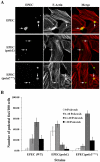The EHEC type III effector NleL is an E3 ubiquitin ligase that modulates pedestal formation
- PMID: 21541301
- PMCID: PMC3082576
- DOI: 10.1371/journal.pone.0019331
The EHEC type III effector NleL is an E3 ubiquitin ligase that modulates pedestal formation
Abstract
Enterohemorrhagic Escherichia coli (EHEC) O157:H7 causes hemorrhagic colitis and may result in potentially fatal hemolytic uremia syndrome in humans. EHEC colonize the intestinal mucosa and promote the formation of actin-rich pedestals via translocated type III effectors. Two EHEC type III secreted effectors, Tir and EspFu/TccP, are key players for pedestal formation. We discovered that an EHEC effector protein called Non-LEE-encoded Ligase (NleL) is an E3 ubiquitin ligase. In vitro, we showed that the NleL C753 residue is critical for its E3 ligase activity. Functionally, we demonstrated that NleL E3 ubiquitin ligase activity is involved in modulating Tir-mediated pedestal formation. Surprisingly, EHEC mutant strain deficient in the E3 ligase activity induced more pedestals than the wild-type strain. The canonical EPEC strain E2348/69 normally lacks the nleL gene, and the ectopic expression of the wild-type EHEC nleL, but not the catalytically-deficient nleL(C753A) mutant, in this strain resulted in fewer actin-rich pedestals. Furthermore, we showed that the C. rodentium NleL homolog is a E3 ubiquitin ligase and is required for efficient infection of murine colonic epithelial cells in vivo. In summary, our study demonstrated that EHEC utilizes NleL E3 ubiquitin ligase activity to modulate Tir-mediated pedestal formation.
Conflict of interest statement
Figures





References
-
- Kaper JB, Nataro JP, Mobley HL. Pathogenic Escherichia coli. Nat Rev Microbiol. 2004;2:123–140. - PubMed
-
- Griffin PM, Ostroff SM, Tauxe RV, Greene KD, Wells JG, et al. Illnesses associated with Escherichia coli O157:H7 infections. A broad clinical spectrum. Ann Intern Med. 1988;109:705–712. - PubMed
-
- Frankel G, Phillips AD, Rosenshine I, Dougan G, Kaper JB, et al. Enteropathogenic and enterohaemorrhagic Escherichia coli: more subversive elements. Mol Microbiol. 1998;30:911–921. - PubMed
Publication types
MeSH terms
Substances
Grants and funding
LinkOut - more resources
Full Text Sources
Other Literature Sources

